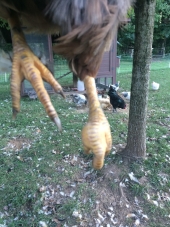












"The world is divided into people who do things, and people who get credit. Try, if you can, to belong to the first class, there is far less competition."
Dwight Morrow
 1
1








Jen Rose wrote:I am no vet. I could be misinformed. But having faced a potential CL threat and having a vet guide me through it here’s what I retained.
I call CL “Cheesy Lump” disease. CL and abscesses are synonymous. The difference is CL abscesses will be filled with a cheese like gunk. And CL abscesses happen in lymph node areas.
I had this concern with an Angora doe I brought in as a rescue. She had a baseball sized abcess on her belly. I consulted my local goat vet heavily prior to home treatment. I lanced the abcess wearing disposable gloves, in a area my other goats would never be living or grazing, over a tarp I was prepared to throw away. If I popped that thing and cheese came out, CL for certain! No cheese, not a CL abcess. So said my wonderful vet. And it wasn’t cheese. She was just neglected and hair and grime was infecting the skin. The theory with the disposable everything and lancing in a remote place is that if it is CL, the curds won’t spread around on and infect the environment and risk infecting other livestock.
I’ve since tested my herd and everyone is indeed negative. CL is supposed to spread via abcess drainage. So an infected goat who is treated or culled appropriately may have posed no risk of spreading to the other goats. It can be managed but culling I believe is best.
I put off testing for years. But I will admit, now knowing everyone is clean sure puts my mind at rest, and makes me think differently about bringing in just any old untested goat!
As to your jaw lump. Could be CL. Could just be cheat grass in the gum, or a jaw tumor, or any number of things, determine if it’s in the bone or flesh, I’ve popped goat abscesses in the cheeks from cheat grass burrowing in! argh!
 1
1





|
Men call me Jim. Women look past me to this tiny ad:
Learn Permaculture through a little hard work
https://wheaton-labs.com/bootcamp
|

